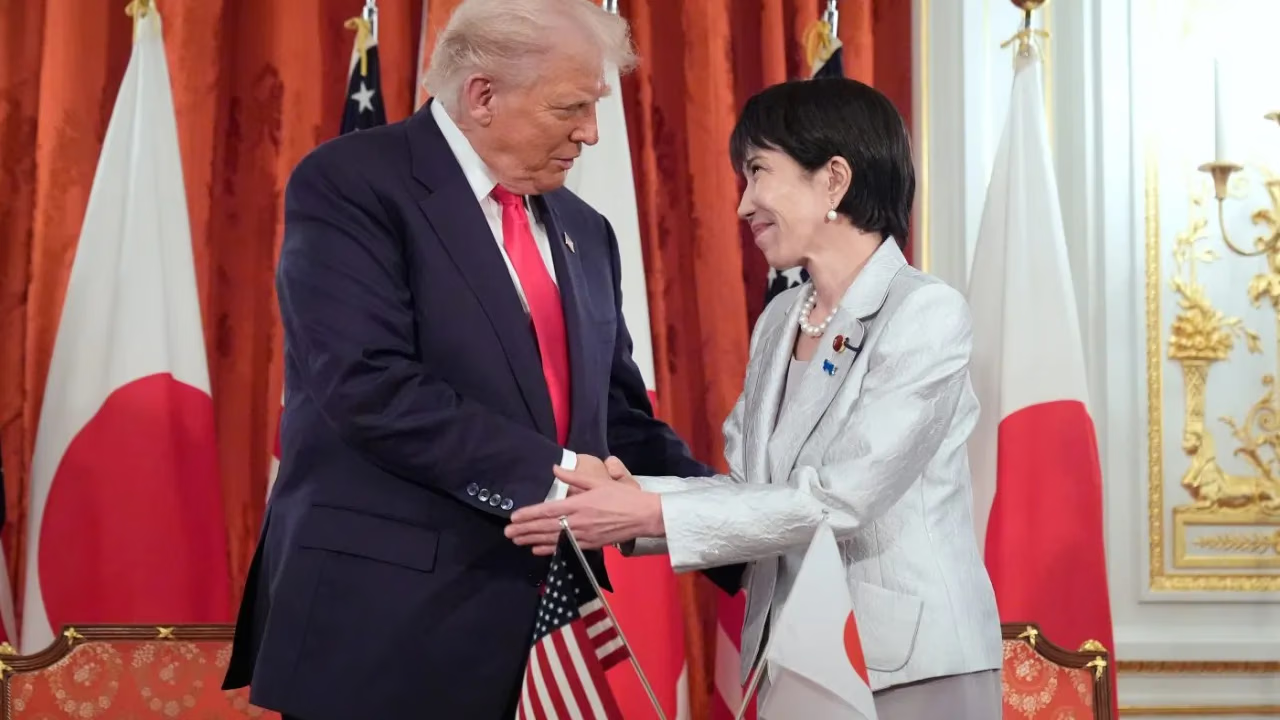Donald Trump’s Asian tour has become a showcase of the return of personal diplomacy to U.S. foreign policy. After he helped broker a cease-fire between Thailand and Cambodia, the president arrived in Japan—one of the key pillars of America’s alliance architecture in the region. In Tokyo, he met with the new prime minister, Sanae Takaichi, who promised a “golden age” of Japan-U.S. relations and an accelerated military modernization program.
During Donald Trump’s visit to Tokyo on Tuesday, Japan’s new prime minister, Sanae Takaichi, expressed enthusiastic support for the U.S. president and pledged the beginning of a “golden age of relations” between the two nations. On the same day, the sides signed an agreement with Washington aimed at strengthening the supply of critical minerals.
According to the White House, Takaichi—the first woman ever to lead Japan’s government—praised Trump’s role in resolving international conflicts and said she intends to nominate him for the Nobel Peace Prize.
Trump, who is touring Asia in an effort to secure a trade deal with China, responded in kind, calling Japan “an ally at the highest level” and emphasizing the importance of partnership in both economic and defense spheres.
The meeting with Trump at the prime minister’s residence was Takaichi’s first personal conversation with the American leader, taking place just days after she assumed office.
“We are allies at the highest level, and it is a great honor to stand beside you—especially at the beginning of a journey that I’m sure will make you one of the greatest prime ministers,” Trump said.
Takaichi, in turn, praised Trump’s efforts to achieve a cease-fire between Thailand and Cambodia and called the Gaza agreement “an unprecedented historic accomplishment.”
“I want to usher in a new golden age of the Japan-U.S. alliance, one in which both Japan and the United States grow stronger and more prosperous,” she said.
In a joint statement, the two sides announced the signing of an agreement aimed at “ensuring the resilience and security of supply chains for critical minerals and rare earth elements.”
A month earlier, Beijing had announced sweeping restrictions on its rare-earth industry, prompting Trump to threaten 100-percent tariffs on Chinese imports in retaliation.
The U.S. president also apologized for being late, explaining that he had been watching the World Series baseball game, where Japanese stars Yoshinobu Yamamoto and Shohei Ohtani were playing for the Los Angeles Dodgers.
Trade and Security as the Core Themes of the Visit
Trump arrived in Tokyo on Monday—his visit serving as an intermediate stop between Malaysia and his upcoming meeting in South Korea with Chinese President Xi Jinping, which is expected to ease the prolonged trade war.
Negotiators from Beijing and Washington confirmed that the world’s two largest economies had reached an understanding to establish a “framework agreement.”
In Tokyo, Trump and Takaichi focused on security and trade issues between the allied nations.
A Tokyo resident, 58-year-old Takashi Ito, said it was “important to find a certain compromise” in trade talks. “Simply raising tariffs has already caused many problems,” he added.
On the security front, Japan—which for decades pursued a pacifist policy—is now strengthening its military capabilities amid worsening relations with China.
Takaichi, known for her hard line on Beijing and having become Japan’s first female prime minister just last week, announced that her government would reach its defense spending target of two percent of GDP this year—two years ahead of schedule.
The United States, which stations about 60,000 troops in Japan, is pressing Tokyo to raise its defense budget even further—potentially to five percent of GDP, as NATO members pledged to do in June.
According to Yi Kuan Hen, professor at the Graduate School of Public Policy at the University of Tokyo, in an effort to “ease U.S. pressure” over higher defense spending, Takaichi “decided to act preemptively” and accelerated the target’s implementation.
In addition to meeting with Takaichi, Trump will deliver a speech on Tuesday aboard the USS George Washington, docked at the U.S. Naval Base in Yokosuka. Later, he will attend a dinner with business leaders, including the chairman of Toyota’s board of directors.
Economic Calculations and Political Signals
Most Japanese goods exported to the United States are subject to tariffs of 15%, a softer rate than the initially threatened 25%. Yet even these duties have led to a 24% year-on-year decline in the value of car exports to the U.S. in September.
The auto industry accounts for about eight percent of Japan’s jobs. Under the trade agreement signed in July and published by the White House, Tokyo also plans to invest $550 billion in the U.S. economy.
Takaichi is seeking to build a constructive relationship with Trump, who maintained close personal ties with the late former prime minister Shinzo Abe. Ahead of the visit, the U.S. president said he had heard “wonderful things” about Takaichi and called her “a great ally and friend of Shinzo Abe, who was my friend.”
In Nara, Takaichi’s hometown in western Japan, the trial of Abe’s alleged assassin, Tetsuya Yamagami, is set to begin—more than three years after the shooting.
Trump’s main goal—shared by global markets—is a trade agreement with China. His first in-person meeting with Chinese President Xi Jinping since the 79-year-old Republican returned to the White House in January is scheduled for Thursday in South Korea.
“I have great respect for President Xi, and I think we’re going to reach a deal,” Trump told reporters en route from Malaysia, where statements by U.S. and Chinese negotiators boosted hopes for a compromise.
He also hinted that he might extend his Asian tour to meet North Korean leader Kim Jong Un, though no such meeting has been officially announced.
